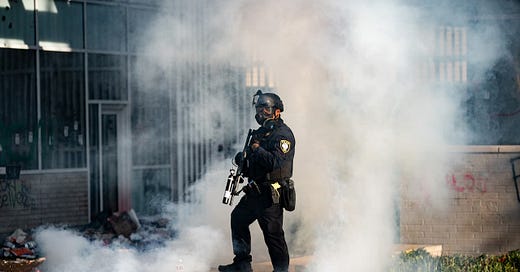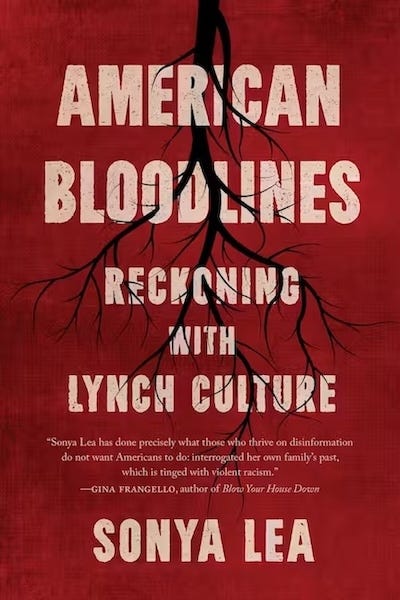This week, some tax-funded, white supremacist, domestic terrorism went down in my new city. I have been here a year, long enough to know that the federal government placed an ICE building next to an elementary school and they’ve been grabbing beloved members of our community from their workplaces, imprisoning them, then expecting there to be no repercussions from the people.
In the past two weeks, when Portland showed up, they showed up peacefully, chanting about illegal arrests, speaking out against the kidnapping of local business people, who also happen to be immigrants. About what you’d expect in a sanctuary city. But then, the feds arrived, (or at least guys that looked like federal officers, some masked and unidentifiable,) and shot tear gas, flash bangs, rubber bullets, pava projectiles, bullet bombs, and VXR sets, which you can buy on Amazon, 12 rounds for $50.
Yesterday, the DHS secretary told Newsweek: "Last night, Portland rioters violently targeted federal law enforcement—250 rioters launched fireworks, shined lasers in officers' eyes to temporarily blind them, and stormed an ICE field office.
FOX News says the protesters were “crushed by federal agents,” as this is the mythology conservatives amplify, a faux-heroic pastiche of ‘law and order’ that has a history trailing all the way back to the Fugitive Slave Act when the federal government deputized citizens, even against their will, and forced them to take part in unlawful groups to seize enslaved people who had escaped north.1
The protesters are not crushed. I doubt you can diminish Portland through arrests or threats of physical harm. There’s a proud history of activism and punk moves here, going all the way back to women’s suffrage, and fights against racial violence.2 From protesting wars, occupations, genocides, labor conditions, racial violence, government pipelines, nuclear plants, killings by police, and even a World Naked Bike Ride to protest oil dependency, Portland is known for being leftist and counterculture, once deemed as “Little Beirut” by daddy Bush.
That history doesn’t stop the ever camera-ready secretary Kristi Noem's message to the Portland protestors: “You will not stop us or slow us down. ICE and our federal law enforcement partners will continue to enforce the law." Seven arrests happened that night, hardly a riot, but you have to listen to more than a dictator-lover to parse the news these days.3
Whose law? is the question many of us are asking in the wake of an authoritarian government who disappears US citizens and brilliant, hardworking immigrants, even though Trump and his Republicans promised to only deport criminals who were the ‘worst of the worst.’
No really, whose law are we using now? Certainly not the unconstitutional law that detained Moises Sotelo-Casas, an entrepreneur who has worked decades in the Willamette Valley as the owner of Novo Start Vineyard Service a company that provides pruning, pest control and harvesting services to vineyards. Many in the wine industry and those who worked alongside Sotelo-Casas responded with passionate outbursts of grief, and anger.4
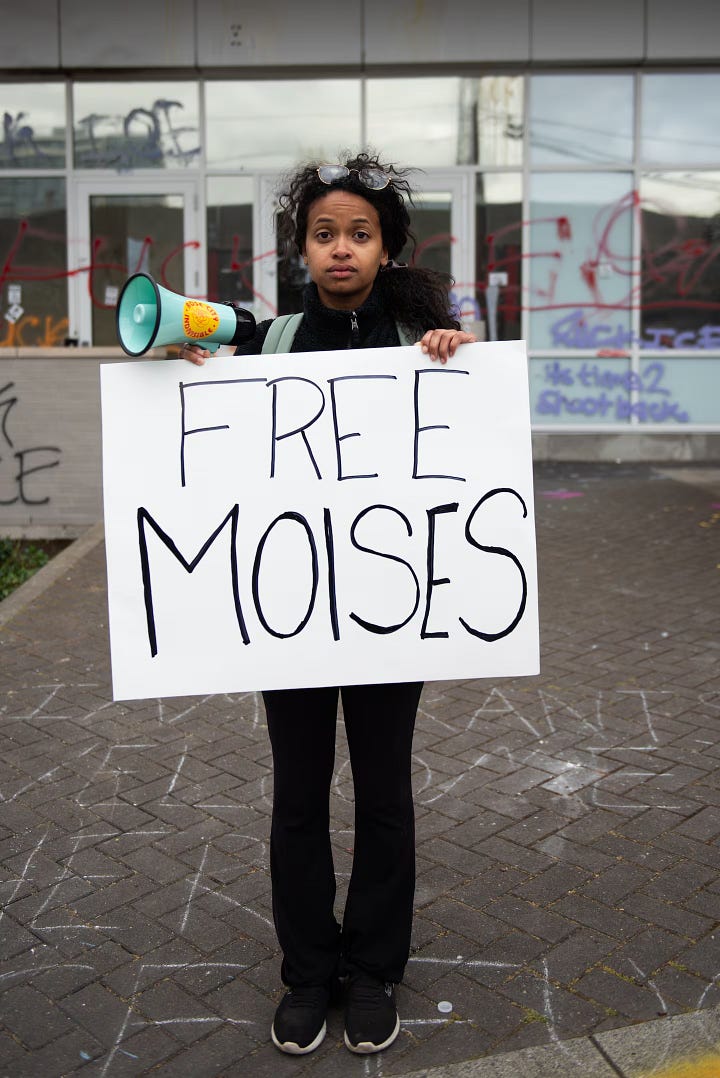
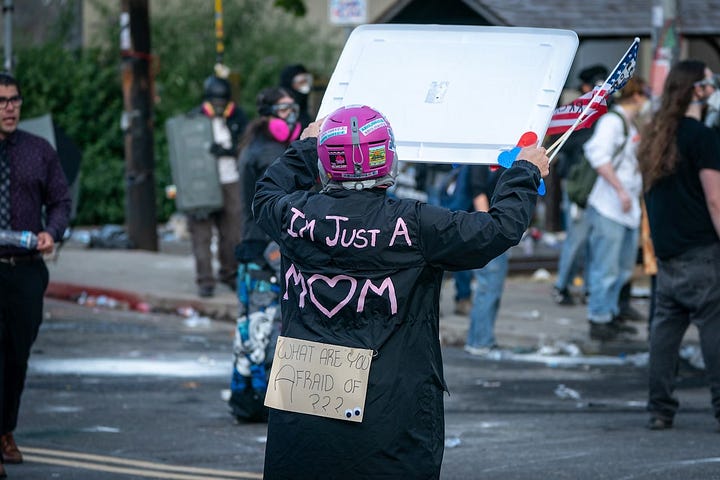
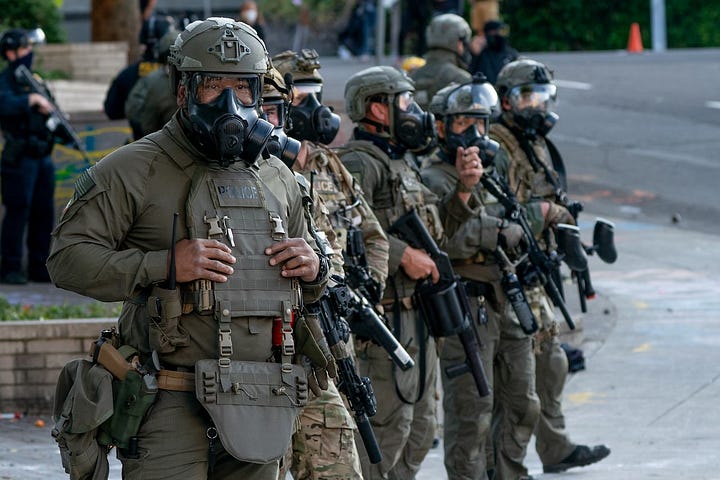
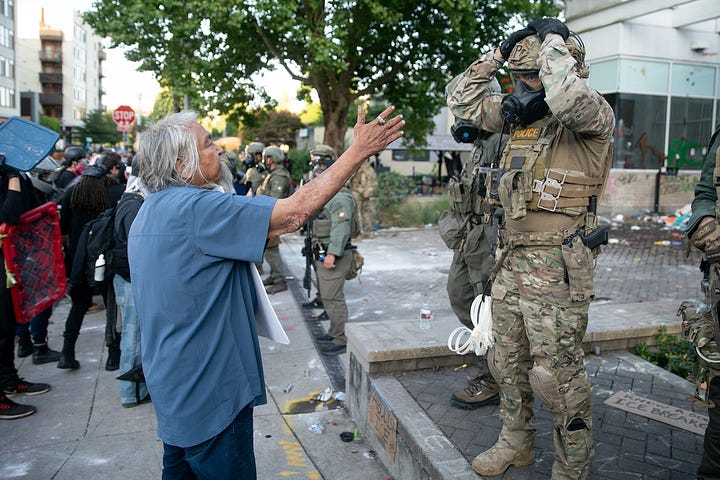
Or the horrible refusal of the law to protect free speech that on No Kings Day allowed a federal officer to shoot a projectile into the crowd, nearly blinding an ER nurse who left work to protest at the South Portland ICE facility.
Earlier this month, on the facade of the ICE building, demonstrators put up a sign that read “Free OJM.” O-J-M is the pseudonym of an asylum seeker who was being sexually assaulted by several members of a Mexican drug cartel for being trans. She was detained by federal officers at Portland Immigration Court, where she was attending a mandatory hearing in her asylum case. U.S. District Court Judge Amy Baggio issued an order that barred ICE from taking O-J-M out of Oregon, but they said they’d already removed the immigrant. Baggio, undeterred prevented the asylum seeker from being removed from the Northwest ICE Processing Center in Tacoma, where she remains.
We showed up at the large Portland No Kings Day protest because we needed community. In these treacherous times for people of color, we wanted to connect with the 50,000 protestors here who were organizing for immigrant rights and standing up in the wake of arrests that continue to happen in this city. Portland would be one of two-thousand protests nationwide. At the waterfront park, there were booths with people organizing for trans rights, support of civil service jobs, climate actions, universal health care, and the liberation of Gaza. We met strangers who shared with us their feelings about what was happening in this country. Some call the marches “performative,” but I found something I needed on this day, a kind of joy and ferocity in a communal NO, moments that I filmed and sent out to folks, and more of a reminder to me of the beautiful magic that happens when people gather with a common purpose.
I remembered the piteous feeling of living in Canada during the first Trump presidency, and not being able to protest, how despondent I was for being ill and unable to travel. (The hardest thing was being away when I needed to be elsewhere, living in Canada was mostly a powerful, astonishing experience.) Instead, here we were in a city of roses and thorns, able-bodied, having the means to demonstrate, to laugh, dance, shout, and make art. We walked the packed streets downtown, ate lunch at a local food truck, moved to and from the MAX light rail talking with neighbors about what they were doing next, how they were using their resources, what their experience of the day had been. Even though a march wasn’t the only thing we did to object, it was so good to be with others who needed each other in the ways that we always do, bodies near, voices raised.
All year we’ve been renovating, hiring immigrant-led businesses who we wanted to support financially, and whose expertise and commitment have made beauty of this 1937 Mediterranean-style home surrounded by the protective giants of Douglas Fir, Norway spruce, a mama eucalyptus and a grandmother big leaf maple. In these months of active work on the house, we lived amongst multi-generational families of craftspeople, Eastern European tradesmen, a team of brothers from Russia, cousins and friends from Latin America, all of them bringing their music and languages and inside-jokes to fill up our rooms with their artistry. We served them morning cups of coffee and pizza lunches, listened to stories in Spanish and English, learned from them about how we might take good care of our home. They welcomed us to their city, gave us some tips on living here, shared some of their challenges with us.
At the same time, we were reckoning with cruel acts based in white supremacy and xenophobia in our President, including supplanting a bipartisan policy because of one man’s ego,5 and a rollout of the kind of fascism developed this last decade through Project 2025, which details a campaign of mass deportation, including Stephen Miller’s goals to arrest, detain, and deport millions of people. Now, the people behind this plan are reckoning with the political costs of the administration’s zero-tolerance enforcement agenda, springing their “fresh” ideas to exempt farms, hotels and restaurants. What shifted didn’t come from working across the aisle to make policy, but instead from calls Republican businesses in the nation’s agricultural regions made, telling how they relied on immigrants — both documented and undocumented — to do their work, to make their profit. But here it is, friends—there will never be enough exemptions. America relies on immigrants for its existence.
I was an immigrant much of my life, one who was brought to Canada as a child, who learned its history and culture not just to fit in, but because I wanted to recognize the land that I stood on. As a white child, I had the privilege of a remarkably easy welcome to that more socialized country where most of my friend’s parents were first generation arrivals. Still, I noticed when immigrants were disparaged and ridiculed, or when refugees were welcomed. More recently, I felt the shift in Canada when public outcry grew over inaccessible social services and unaffordable housing, issues that residents (denying their presence on stolen land) believed, placing blame on notions of multiculturalism and increasing streams of immigrant populations.
While the US has long had more immigrants than any other country, foreign-born people make up one-quarter of Canada’s population, one of the highest ratios for industrialized Western nations.6 In recent years, across Canada and the US, as well as Europe, there’s been dwindling support for immigration.7 Research says the cause might be the growing awareness of the climate crisis, and its perceived lack of resources. There are massive societal problems associated with perceived scarcity, not the least of which has shown up in the recent US presidential election—the fear that the identity group we associate with will diminish. White nationalism is built on such fears of losing power and dominance, the kind of hierarchical mindset that is (rightly) being threatened in this era.
The real thing that can end perceptions of scarcity is kinship. There’s nothing to be lost when our frame of existence is in already being joined with everything.
Naomi Klein talked about eroding our human sense of deficit when she posed at the end of a mostly terrific conversation on the new shock doctrine the possibility that we might shift perceptions to everyone having a sense of being chosen. That phrase feels too religious to me, and essentially is a problem of whiteness, for those who can’t locate kinship and a mutuality in being alive are often white folks who carry conscious or unconscious racial constructs that separate us from others. It’s part of the way whiteness was born in us, a whiteness that’s not a biological fact but rather a social construction with boundaries that shift over time. I learned this from reading Noel Igantiev’s talks, books, and radical journals like Race Traitor, and from doing the research for my upcoming book, American Bloodlines: Reckoning with Lynch Culture.
I’ve been talking with friends about how this whiteness might be a deflection that happened when we immigrated across oceans, losing contact with all that came before, cutting off others as an instinct to survive in this new country. I think it doesn’t really matter how it happened, except as a way to acknowledge the journey of our ancestors, to see them in their fullness. What does matter is that we can be open to spontaneous revolutionary change, the kind that Ignatiev believed in. Like him, I know that whiteness can be created, and that means it can also be destroyed. White privilege is built today in the same ways as our ancestors experienced, as a deceptive tactic wielded by bosses (and Presidents) to trick exploited workers into believing that they’re “white,” and therefore immune from being deported, detained, disappeared. But y’all already know, if they can do it to them, they will do it to you.
Go find your kin. Let’s end this shit together.
There’s some big things happening around the launch of my book in October. A writer I greatly admire wrote a few words about my work. Irvin Weathersby, Jr. had one of my favorite books of the year, a work that was acclaimed everywhere, what Kiese Laymon called “one of the most memorable books of the decade,” In Open Contempt: Confronting White Supremacy in Art and Public Space. Weathersby’s book will help you understand white supremacy more fully, and open your mind to the public spaces where it exists.
“In American Bloodlines, Sonya Lea reveals the ways that whiteness harms through an exhaustive, often vulnerable, excavation of her privilege and learned racism. She illustrates the hatred animated in her ancestry with a courageous sobriety that emerges through countless interviews, poignant recollections, and meticulous research. The result is an engaging blueprint for the repair of self and one's community from an underexplored perspective. American Bloodlines is required reading for all those still uncertain about the murderous outcomes of white supremacy and for all those who yearn to heal.”—Irvin Weathersby Jr., In Open Contempt: Confronting White Supremacy in Art and Public Space
If you pre-order American Bloodlines here or anywhere you buy books, there’s a better chance this book makes it into conversations where it’s needed. Thank you for reading, friends.
In other news:
There’s a terrific new podcast by my friend Holly Whittaker, called Co-Regulation. I’ve loved each of the episodes, including the interview with Chris La Tray, How to be a Dissident, which anchored me a lot during this time of disruption and chaos, not the least of which was gaining a historical perspective from Indigenous people who have been in this for a few hundred years. I also really loved the prepper talk with J Wortham on How to Stay Present During Collapse. Holly is a powerful interviewer who goes in honestly and transparently and I find myself held by these dialogues in a way that counters all the f***ing lying happening all around us. Enjoy the beauty.
I love you, kin,
Sonya
Welcome to all the new subscribers here!
Thanks for reading and for supporting my work. I’m thrilled that you’ve joined this community. I write books and essays, including my memoir, Wondering Who You Are, and my work in American Bloodlines: Reckoning with Lynch Culture, out this autumn. You can pre-order the book, which matters enormously for an independent press with limited resources publishing work that’s significant to a region and its people.
This community of Wanderland was originally formed when my partner and I sold our home in Canada and went out traveling for nine months to see how idiosyncratic wandering might impact us. I’ve since included subjects related to more of an inner gallivanting, including nondual philosophy, which has been a passion since my partner went to surgery and came out without his memories or history or personality. There are posts that end up encompassing some elements of physical wandering and other kinds of mooching about. I live in Portland Oregon, where I enjoy hiking, preserving foods, eating at food trucks, wandering book stores, and engaging with community to end mass deportations and other racial violences.
The Fugitive Slave Act began in my home state of Kentucky when several hundred enslaved people settled along the Underground Railroad in Michigan, and attracted the attention of Southern enslavers. In 1847 and 1849, planters from Kentucky, led raids into Cass County to recapture people escaping enslavement. The attacks and a legal case failed, but the situation contributed to Southern demands in 1850 to pass a strengthened fugitive slave act.
Leaders like Beatrice Morrow Cannady, who helped found the Portland chapter of the NAACP and was on the editorial staff of The Advocate, organized Portland's protest to the racist film The Birth of a Nation in 1915. The protests resulted in a city ordinance banning films that incite racial hatred.
Lawful or rioters? Be careful who you’re calling a coward, Homeland Security. https://www.oregonlive.com/portland/2025/06/largely-lawful-or-violently-rioting-portland-police-and-feds-split-on-nightly-ice-protest.html
A Gofundme has been set up for his family, who are dealing with expenses after this ICE detainment.
During the presidential campaign, Republicans in both the House and Senate yielded to objections from their all-but-certain presidential nominee, former president Donald Trump to kill months of effort in creating a bipartisan immigration bill. The first Trump administration used the COVID pandemic to employ emergency public health measures to all but close the southern border to unauthorized border crossers, testing their strategy of using “extraordinary measures” to stop asylum seekers at the southern border.
See Pew Research for details on how the US is home to one-fifth of the world’s migrants. https://www.pewresearch.org/short-reads/2024/09/27/key-findings-about-us-immigrants/
In 2024, Canada reduced the number of permanent residents accepted into the country by 21%, made cuts to its temporary foreign workers program and its international students program. A majority of Canadians have long been welcoming to newcomers, but are now questioning how their cities can manage. In 2022, 27% of Canadians said there were too many immigrants coming into the country, according to a survey by data and research organization the Environics Institute for Survey Research. By 2024, that number had increased to 58%. (BBC) (Council on Foreign Relations)

